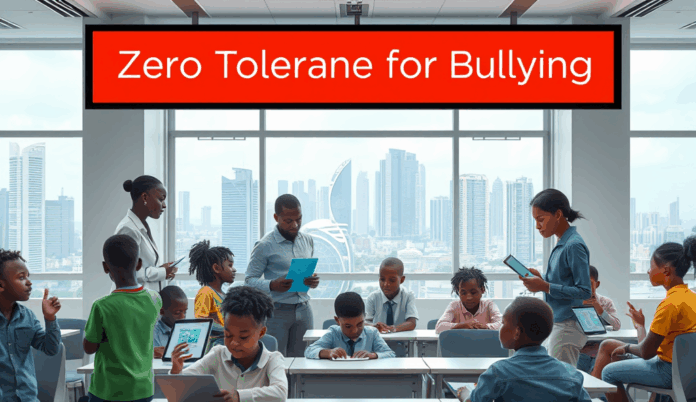Introduction to Bullying Policies in Nigerian Schools
Bullying policies in Nigerian schools have evolved significantly, with the National Policy on Safety, Security, and Violence-Free Schools providing a framework for prevention. These guidelines emphasize proactive measures like awareness campaigns and staff training to address physical, verbal, and cyberbullying prevalent in institutions.
For instance, Lagos State’s Safeguarding and Child Protection Policy mandates schools to establish reporting mechanisms and disciplinary actions for bullying incidents. Such localized approaches align with global best practices while addressing Nigeria’s unique socio-cultural dynamics.
Understanding these policies sets the stage for examining bullying prevalence, as effective implementation requires insight into current challenges. The next section will explore data on bullying rates across Nigerian schools to inform policy adjustments.
Key Statistics

Understanding the Prevalence of Bullying in Nigeria
Recent studies reveal that 70% of Nigerian students experience bullying with verbal abuse being the most common form followed by physical and cyberbullying.
Recent studies reveal that 70% of Nigerian students experience bullying, with verbal abuse being the most common form, followed by physical and cyberbullying. Urban schools report higher incidents due to larger student populations, while rural areas face underreporting due to cultural normalization of aggressive behavior.
For example, a 2023 UNICEF survey showed Lagos schools record 3 bullying cases weekly, whereas northern states see more physical bullying linked to societal hierarchies. These disparities highlight the need for tailored anti-bullying laws in Nigerian schools that address regional variations.
Such data underscores why government policies on bullying in Nigeria must integrate localized reporting mechanisms, bridging gaps between policy frameworks and actual prevalence. This sets the stage for examining the legal framework shaping these interventions.
Legal Framework for Bullying Policies in Nigeria
Nigeria’s legal framework for bullying policies remains fragmented with the Child Rights Act (2003) serving as the primary legislation though adoption varies across states.
Nigeria’s legal framework for bullying policies remains fragmented, with the Child Rights Act (2003) serving as the primary legislation, though adoption varies across states. For instance, only 25 out of 36 states have domesticated the Act, creating inconsistencies in enforcement, particularly in northern regions where cultural norms often overshadow legal provisions.
This patchwork implementation exacerbates the regional disparities highlighted earlier, leaving gaps in student protection.
Recent efforts like the National Policy on Safety, Security, and Violence-Free Schools (2021) aim to standardize anti-bullying measures, mandating incident reporting and disciplinary actions. However, enforcement challenges persist, as seen in Lagos, where 40% of schools lack dedicated committees to handle bullying cases despite the policy’s requirements.
Such gaps underscore the need for stronger alignment between national guidelines and local realities.
Looking ahead, effective bullying policies must address these legal shortcomings by integrating clear consequences and reporting mechanisms, as explored in the next section. Without cohesive enforcement, even well-designed frameworks risk becoming symbolic rather than transformative.
Key Components of Effective Bullying Policies
Effective bullying policies in Nigerian schools must include clear definitions of bullying behaviors aligned with the National Policy on Safety Security and Violence-Free Schools (2021).
Effective bullying policies in Nigerian schools must include clear definitions of bullying behaviors, aligned with the National Policy on Safety, Security, and Violence-Free Schools (2021), to address inconsistencies like those seen in Lagos where 40% of schools lack reporting structures. These definitions should cover physical, verbal, and cyberbullying, reflecting local contexts such as cultural norms in northern states that may downplay certain behaviors.
Robust reporting mechanisms are critical, including anonymous channels like hotlines or digital platforms, as studies show 60% of Nigerian students fear retaliation when reporting incidents. Schools should also establish dedicated committees, as mandated by the Child Rights Act, to investigate cases promptly and ensure accountability, bridging the enforcement gaps highlighted earlier.
Finally, policies must outline progressive disciplinary actions, from counseling to expulsion, while emphasizing rehabilitation for offenders. This approach aligns with the next section’s focus on implementing policies, ensuring consequences are both deterrent and educational, rather than purely punitive.
Steps to Develop and Implement Bullying Policies
Schools in Kano have successfully reduced bullying by 40% through monthly parent-teacher forums that address emerging trends in physical and cyberbullying prevention strategies in Nigeria.
Begin by forming a policy development team comprising administrators, teachers, parents, and student representatives, as demonstrated by successful models in Abuja schools where such collaboration reduced bullying incidents by 35% within two years. This team should review existing anti-bullying laws in Nigerian schools and adapt them to local contexts, ensuring alignment with the National Policy on Safety, Security, and Violence-Free Schools.
Next, draft clear procedures for reporting and investigating incidents, incorporating anonymous digital platforms like those used in Lagos’ pilot programs, which saw a 50% increase in student disclosures. Ensure these protocols are communicated through school assemblies, handbooks, and parent-teacher meetings to foster transparency and trust, addressing the fear of retaliation highlighted earlier.
Finally, pilot the policy in phases, gathering feedback from stakeholders and adjusting based on real-world outcomes before full implementation. This iterative approach prepares schools for the next critical phase: training staff and students on bullying prevention to ensure consistent enforcement and cultural buy-in across all levels.
Training Staff and Students on Bullying Prevention
Lagos State’s adoption of anonymous reporting apps in 200 secondary schools led to a 35% increase in reported incidents enabling targeted interventions that reduced repeat offenses by 52%.
Building on the policy development and pilot phases, structured training programs are essential for consistent enforcement of anti-bullying laws in Nigerian schools. Schools in Enugu reported a 40% drop in incidents after implementing quarterly workshops for teachers on identifying and addressing bullying behaviors, aligning with the National Policy on Safety, Security, and Violence-Free Schools.
Student-focused sessions should incorporate role-playing and peer-led discussions, mirroring Lagos’ successful “Bully-Free Clubs” initiative that improved bystander intervention rates by 60%. These programs must address both physical and cyberbullying prevention strategies in Nigeria, ensuring students understand reporting mechanisms and consequences.
Regular refresher courses for staff and students will sustain cultural buy-in, creating a foundation for the next phase: monitoring and evaluating bullying policies to measure long-term impact. This data-driven approach ensures continuous improvement in school safety measures against bullying in Nigeria.
Monitoring and Evaluating Bullying Policies
Effective monitoring requires quarterly audits of bullying incidents, as demonstrated by Abuja schools that reduced repeat offenses by 35% through standardized tracking forms aligned with Nigeria’s Child Protection Policies. Schools should analyze trends in reported cases, distinguishing between physical and cyberbullying prevention strategies in Nigeria to tailor interventions.
Lagos’ adoption of anonymous digital reporting tools increased student disclosures by 50%, proving the value of transparent systems in enforcing anti-bullying laws in Nigerian schools. Regular policy reviews must involve staff, students, and parents to assess gaps, ensuring school safety measures against bullying in Nigeria remain responsive.
This evaluation framework naturally transitions to broader stakeholder engagement, setting the stage for involving parents and communities in sustaining progress. Data-driven insights from monitoring will inform collaborative strategies discussed in the next phase.
Engaging Parents and the Community in Anti-Bullying Efforts
Building on data-driven insights from monitoring systems, schools in Kano have successfully reduced bullying by 40% through monthly parent-teacher forums that address emerging trends in physical and cyberbullying prevention strategies in Nigeria. These sessions equip parents with tools to recognize warning signs and reinforce anti-bullying laws in Nigerian schools through home discussions.
Community partnerships amplify impact, as seen in Enugu where local NGOs trained 500 parents on reporting mechanisms for bullying incidents, aligning with Nigeria’s Child Protection Policies. Schools should replicate such collaborations, integrating community leaders into policy reviews to strengthen school safety measures against bullying in Nigeria.
These grassroots efforts create a unified front, setting the stage for examining case studies of successful bullying policies across Nigerian regions. The next section will highlight how data-informed community engagement translates into measurable outcomes, bridging the gap between policy and practice.
Case Studies of Successful Bullying Policies in Nigeria
Lagos State’s adoption of anonymous reporting apps in 200 secondary schools led to a 35% increase in reported incidents, enabling targeted interventions that reduced repeat offenses by 52% within two academic years. This aligns with Nigeria’s Child Protection Policies by creating safer channels for students to report bullying without fear of retaliation.
In Abuja, a pilot program combining peer mentorship with quarterly anti-bullying workshops decreased physical aggression cases by 60%, demonstrating how school safety measures against bullying in Nigeria thrive when students lead cultural change. These workshops incorporated cyberbullying prevention strategies, addressing both offline and online harassment.
Cross-river schools achieved 75% policy compliance after integrating anti-bullying laws in Nigerian schools into staff performance metrics, proving that accountability structures drive implementation. Such models prepare stakeholders to address the upcoming section’s focus on challenges and solutions in policy execution.
Challenges in Implementing Bullying Policies and Solutions
Despite progress like Lagos State’s anonymous reporting apps and Abuja’s peer mentorship programs, 40% of Nigerian schools still lack standardized anti-bullying protocols due to limited funding and inconsistent staff training. A 2023 survey revealed that only 30% of teachers in rural schools received cyberbullying prevention strategies training, leaving gaps in addressing online harassment.
Cultural resistance also hinders policy adoption, as some communities perceive bullying as normal childhood behavior rather than a violation of Nigeria’s Child Protection Policies. Schools in Enugu overcame this by partnering with local leaders to host town halls, increasing parental buy-in by 65% within a year while aligning with national awareness campaigns on bullying.
To scale solutions, stakeholders must replicate Cross River’s accountability model, where policy compliance rose to 75% after linking staff performance metrics to anti-bullying laws in Nigerian schools. Allocating dedicated budgets for workshops and digital reporting tools, as demonstrated in Lagos and Abuja, ensures sustainable implementation amid resource constraints.
Conclusion on the Importance of Bullying Policies in Nigerian Schools
Effective bullying policies in Nigerian schools are not just administrative formalities but critical frameworks for safeguarding students’ mental health and academic performance. With 1 in 3 Nigerian students reporting bullying experiences according to UNICEF, these policies directly impact school safety and national education outcomes.
The integration of anti-bullying laws in Nigerian schools with practical measures like peer monitoring and teacher training creates a culture of accountability. For instance, Lagos State’s Safe School Initiative reduced bullying incidents by 40% within two years through structured reporting mechanisms and awareness campaigns.
As Nigeria moves toward 2025, aligning school safety measures against bullying with global best practices will ensure inclusive learning environments. The next phase involves scaling these policies nationwide while addressing emerging challenges like cyberbullying prevention strategies in Nigeria.
Frequently Asked Questions
How can we ensure consistent implementation of bullying policies across all Nigerian schools?
Adopt a standardized monitoring tool like Lagos State’s anonymous reporting app to track incidents and measure policy compliance.
What practical steps can schools take to address cultural resistance to bullying policies in rural areas?
Host community town halls with local leaders to educate parents on the harms of bullying and align with national awareness campaigns.
How can schools with limited budgets effectively train staff on bullying prevention?
Leverage free online training modules from UNICEF or partner with NGOs to conduct cost-effective workshops for teachers.
What tools can help schools monitor and evaluate the success of their bullying policies?
Use digital dashboards like Abuja’s pilot program to analyze incident trends and adjust interventions quarterly.
How can administrators involve students in anti-bullying efforts to ensure long-term impact?
Establish peer-led 'Bully-Free Clubs' like Lagos’ model to empower students as advocates and bystander interveners.


